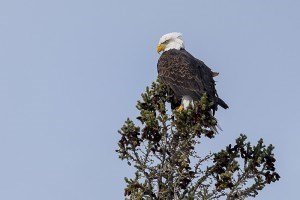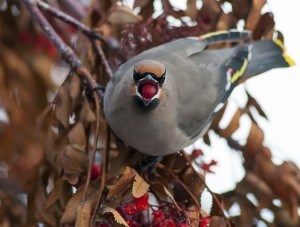
Jasper’s birders spotted 853 birds and 36 different species during the annual Christmas Bird Count, Dec. 20.
While slightly lower than last year, the count is not a precise science and fluctuates from year to year, explained Gord Ruddy, a long-time birder who has been running the count for well over a decade.
“That’s a little down from last year, but last year was a good year,” he said, explaining birders usually spot between 30 to 44 different species each year.
To count the birds, six volunteers spread out within a 12.5-km radius circle from the first bridge at Maligne Canyon, explained Ruddy.
The volunteers were then spilt into two groups, either counting birds at bird feeders or out in the field.
After the birds were counted, Ruddy then went over the data to calculate the total number of birds that were spotted and how many different species were seen before submitting the information to Bird Studies Canada and the National Audubon Society, an American-based organization dedicated to bird conservation.
“Things fluctuate back and forth. We miss tons of birds, but it’s the accumulation of data that makes it valid scientifically,” said Ruddy, explaining this is the 116th annual Christmas Bird Count organized across North America.
“Probably the most interesting bird we saw was the killdeer, which is a plover,” said Ruddy, explaining it was spotted on the Athabasca River near the Fairmont Jasper Park Lodge.
Volunteers also reported seeing three bald eagles and a white-breasted nuthatch.
“White-breasted nuthatches are not common here, [but] for the last three years there’s been white-breasted nuthatches on our count so things are changing,” said Ruddy, explaining it might be because conditions are changing in the Prairies where the birds normally reside.
Of the birds that were spotted, Ruddy said he was surprised to count 29 rock pigeons this year.
“Christmas bird counts for the past 20 years have shown between eight and 10 rock pigeons, this year I got 29 and I don’t think I got them all,” said Ruddy. “That’s three times what we normally count.”
He said he normally counts around 16 pigeons in August, but this year he counted 37 by the end of the summer.
“Normally if I count 16 or 20 pigeons at the end of August we’ll be down to eight or so by the Christmas Bird Count, because northern goshawks, prairie falcons and maybe the occasional peregrine eat them in the fall,” said Ruddy.
“This year they don’t seem to have eaten as many.”
Another change this year was the number of common ravens counted around the transfer station.
“The common ravens at the dump have dipped from around 400 on a couple of counts to 172 this year. I don’t know if that means we have less ravens or that we are more accurate counters than we were in the old days,” said Ruddy, explaining the numbers seem to be steadily dropping year after year.

He also noted that volunteers didn’t count as many bohemian waxwings as previous years, attributing the drop to the successful mountain ash berry crop this year across Alberta.
“Those birds come from the north until they hit the berry crop and often they have to keep going right past here until they get down into the northern states or down into southern B.C., but this year there’s such a big berry crop in northern Alberta that they just haven’t gotten here yet.”
One of the biggest challenges with any bird count is estimating how many birds are in a flock, explained Ruddy.
“Typically with 500 birds or less people underestimate and typically with more than 500 birds people overestimate,” said Ruddy, who is taking a course to help him better estimate how many birds are in a flock.
Over the course of his lifetime, Ruddy said he has noticed a decline in the number of birds that he regularly sees in Jasper.
“In the last 50 years the total bird population of North America has disappeared by 50 per cent, that’s a lot of birds missing.”
For more information about bird conservation and the annual Christmas Bird Count, visit www.audubon.org.
Paul Clarke
[email protected]
